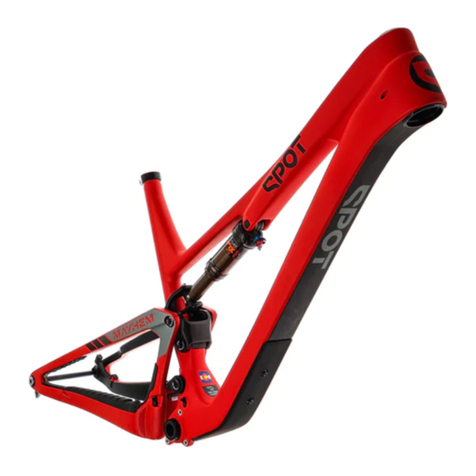3
Rollik 150 Component Compability
Your Rollik 150 frame was designed to work with the following components. Other components
may be compable, but tment is not guaranteed. For quesons regarding component compa-
bility for parts not listed below please contact Spot.
Warning
Like any sport, bicycling involves risk of injury and damage. By choosing to ride a bicycle, you as-
sume the responsibility for that risk, so you need to know—and to pracce— the rules of safe and
responsible riding and of proper use and maintenance. Proper use and maintenance of your bicy-
cle reduces the risk of injury or death.
All bicycles should be assembled and maintained by an authorized bicycle mechanic. If you are not
qualied to assemble, inspect, and maintain your bicycle, please visit your favorite local bike shop
or contact Spot Brand for a referral to a qualied bicycle technician in your area.
This guide covers the details specic to working with your Living Link™ frame. It does not address
complete bicycle assembly, ng, inspecon, maintenance, or riding techniques. Please refer to
the Spot Brand Bicycle Owner’s Manual for further details.
Under no circumstances shall Spot Brand LLC be held liable for direct, incidental, or consequenal
damages, including, without limitaon, damages for personal injury, property damage, or econom-
ic losses, whether based on contract, warranty, negligence, product liability, or any other theory.
COMPONENT FIT/STANDARD
HEADSET UPPER: ZS44, LOWER: ZS56
BOTTOM BRACKET 73mm THREADED
SEATPOST Ø31.6, INTERNAL DROPPER ROUTING
1X DRIVETRAIN 52mm "BOOST" CHAINLINE REQUIRED, DIRECT MOUNT CHAINRING REQUIRED, 34t MAX
REAR HUB 12 X 148mm, SRAM MAXLE REAR AXLE INCLUDED
REAR BRAKE Ø160 NATIVE POST MOUNT, Ø180mm MAX ROTOR DIAMETER
REAR TIRE 29 X 2.6" / 66mm MAX WIDTH, Ø710mm MAX DIAMETER. NOTE THAT ACTUAL TIRE WIDTHS
CAN VARY FROM PRINTED SIZES
REAR SHOCK 210 X 55, FRONT EYELET: Ø8 X 20, REAR EYELET OPEN Ø12.7 BUSHING
SEATPOST COLLAR Ø35.0mm
FORK TRAVEL 150-160mm
WATER BOTTLE 2X BOTTLE MOUNTS, ONE ABOVE AND ONE BELOW THE DOWNTUBE
CHAIN GUIDE ISCG-05 TABS, LARGE UPPER GUIDES MAY NOT FIT. CONTACT SPOT FOR RECOMMENDATIONS




























